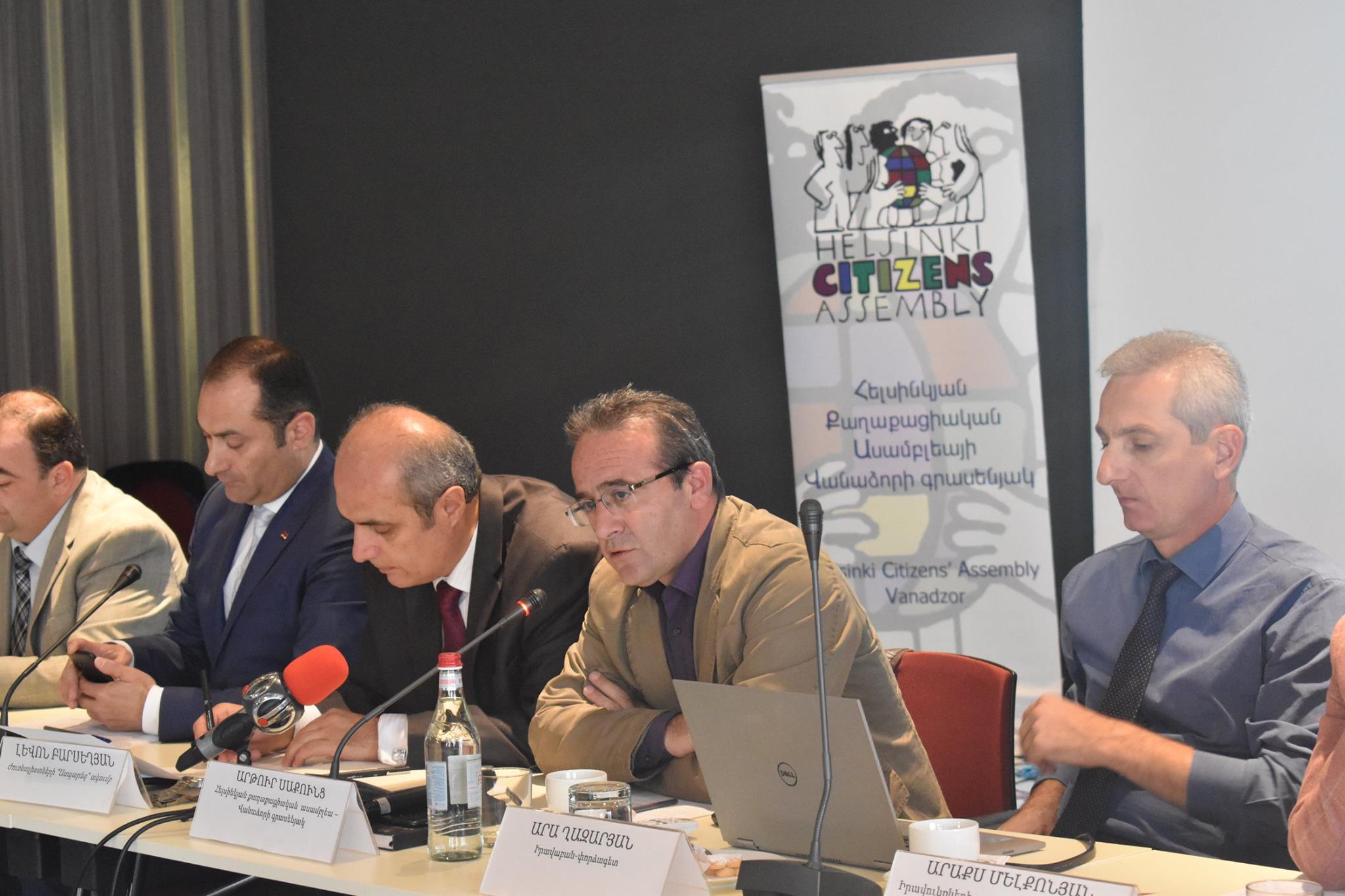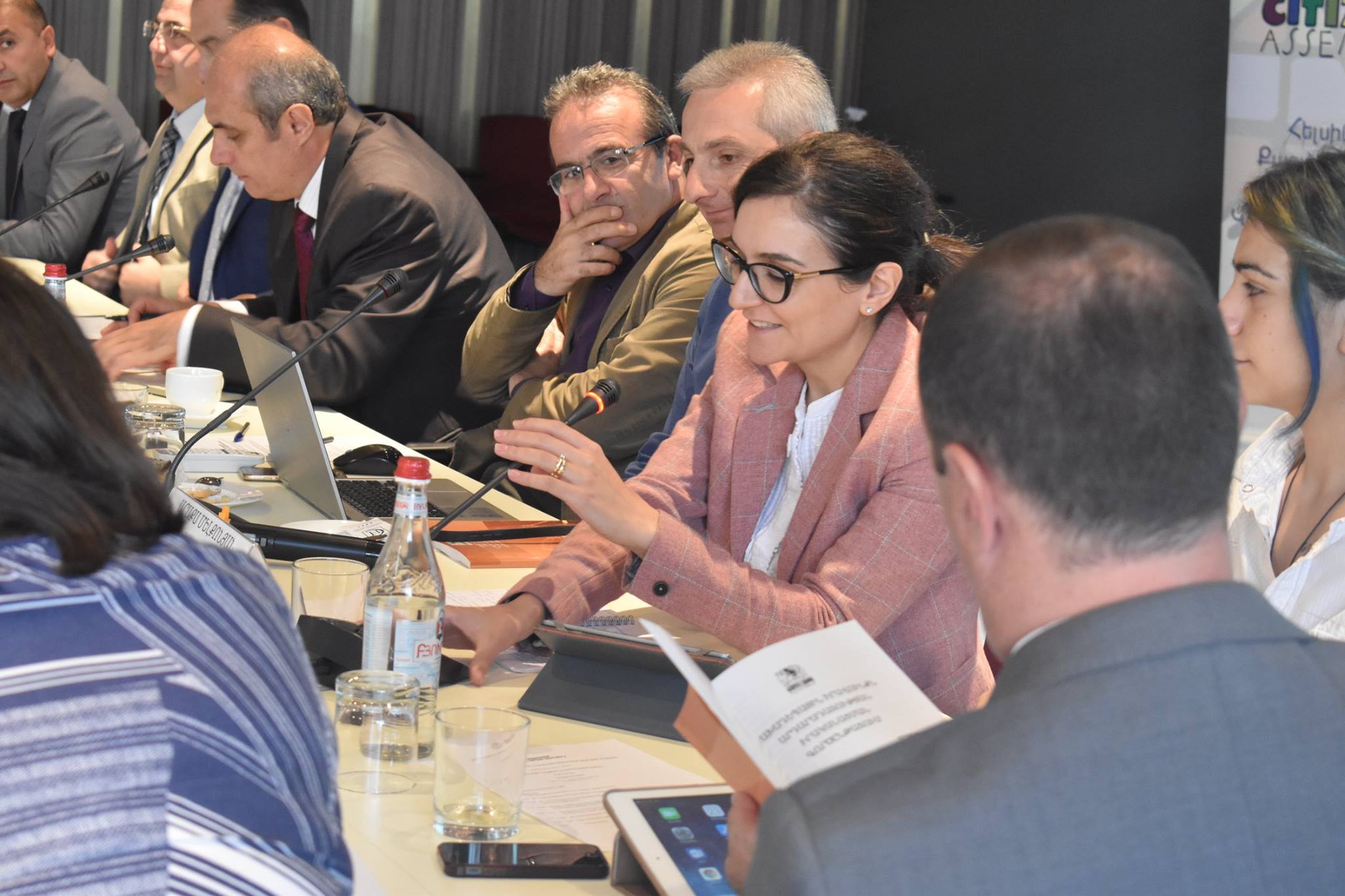The Role of Strategic Litigation in Justice System Reform
On October 23, 2018 the Partnership for Open Society initiative held another edition of their public discussion series, New Armenia: justice and good governance reform agenda. With a view to Armenia’s democratic transition and strategies to pursue systemic change, the discussion focused on the role of strategic litigation in justice system reform. The partnership invited key experts to lead the discussion as panelists. Artak Zeynalyan, Acting Minister of Justice; Artyom Sedrakyan, representative of the Human Rights Defender of Armenia; Artur Sakunts, President of Helsinki Citizens’ Assembly-Vanadzor Office; Ara Ghazaryan, lawyer and expert; Araks Melqonyan, Legal Expert at Protection of Rights Without Borders NGO; Karen Tumanyan, attorney, and Levon Barseghyan, Head of Council at Journalists’ Club “Asparez,” who moderated the discussion. The event gathered a mixed audience including officials, lawyers, journalists, academics and civil society organization to encourage a comprehensive and far-reaching discussion.
Strategic litigation is a method of identifying cases to be taken to court as part of an overall strategy of achieving justice sector reform. The goal of strategic litigation, also referred to as impact litigation, stretches beyond the individual case and its outcomes. Lawyers and organizations engage in strategic litigation to advocate for human rights issues and to bring about legal and social changes.
 In the opening remarks, Acting Minister of Justice, Artak Zeynalyan welcomed the discussion and the attention attributed to strategic litigation. He underlined that in Armenia, the discussions on strategic litigation had been a topic of narrow and specialized circles, while the society, for the most part, remained uninformed about it. He reminded that the cases of strategic litigation started in 2001 in Armenia, when the principle of setting legal precedent (known as stare decisis) was introduced through Armenia’s membership to the Council of Europe and its annual reports to the European Court of Human Rights. Mr Zeynalyan recalled that very few organizations and individuals undertook strategic litigation cases in the beginning, and the majority looked at it with scepticism. It was through the devoted work of certain individuals and organizations that this method brought tangible gains in Armenia. From 2006, he noted, the Court of Cassation started to accept cases of strategic litigation, and most of those cases established precedents in Armenia, such as on one of the most important rights—the free access to information. The Acting Minister stressed that strategic litigation is a composition of legal, scientific and practical processes and should be seen as critical for the legislative system in Armenia and its development.
In the opening remarks, Acting Minister of Justice, Artak Zeynalyan welcomed the discussion and the attention attributed to strategic litigation. He underlined that in Armenia, the discussions on strategic litigation had been a topic of narrow and specialized circles, while the society, for the most part, remained uninformed about it. He reminded that the cases of strategic litigation started in 2001 in Armenia, when the principle of setting legal precedent (known as stare decisis) was introduced through Armenia’s membership to the Council of Europe and its annual reports to the European Court of Human Rights. Mr Zeynalyan recalled that very few organizations and individuals undertook strategic litigation cases in the beginning, and the majority looked at it with scepticism. It was through the devoted work of certain individuals and organizations that this method brought tangible gains in Armenia. From 2006, he noted, the Court of Cassation started to accept cases of strategic litigation, and most of those cases established precedents in Armenia, such as on one of the most important rights—the free access to information. The Acting Minister stressed that strategic litigation is a composition of legal, scientific and practical processes and should be seen as critical for the legislative system in Armenia and its development.
Continuing the discussion about the importance of strategic litigation, Artyom Sedrakyan, representative of the Human Rights Defender of Armenia, emphasized how it served as a bridge between the government and public interests. He noted that strategic litigation should be central to the reforms in the judiciary, and further pointed out the engagement of the Human Rights Defender into strategic litigation cases by accepting the applications of cases and of human rights issues, applying to the Constitutional Court or taking the role of amicus curiae to assist a court by offering expertise on the case. Mr Sedrakyan mentioned that the most important factor in strategic litigation was the initiative of raising the case. For this matter he expressed his gratitude to the Partnership for Open Society, the OSF-Armenia and Helsinki Citizens’ Assembly-Vanadzor Office, for their consistent and untiring work to develop strategic litigation in Armenia and for the major role they had played in raising significant cases.
Talking from the perspective of democratic transition and reforms in Armenia, Arthur Sakunts, noted that previously strategic litigation helped to display systemic and legislative flaws with very little to no possibilities to act upon them. After the revolution, strategic litigation acquired a new role, as the knowledge and experience of individuals and organizations accumulated through numerous strategic litigation processes could serve as the basis for legislative and judiciary reform, but also, for focusing on changing broader patterns of behavior and practices in the judiciary system. Sakunts underscored the difference  between the legal service organizations and human rights organizations in that the latter would take the cases to raise issues of public interest and to bring policy changes rather than just providing the best legal services. He reminded that though several years ago the Constitutional Court had recognized that civil society organizations could take cases of public interest to a court, the previous government did not prepare any legal mechanisms for enforcement of this right either in the law of non-governmental organizations or in any related legislative texts. Mr Sakunts insisted that the new government of Armenia should demonstrate the importance attributed to the role of strategic litigation by extending the application of this method to civil society and recognizing the legitimacy of civil society organizations to become a proper plaintiff for the cases of public interest litigation.
between the legal service organizations and human rights organizations in that the latter would take the cases to raise issues of public interest and to bring policy changes rather than just providing the best legal services. He reminded that though several years ago the Constitutional Court had recognized that civil society organizations could take cases of public interest to a court, the previous government did not prepare any legal mechanisms for enforcement of this right either in the law of non-governmental organizations or in any related legislative texts. Mr Sakunts insisted that the new government of Armenia should demonstrate the importance attributed to the role of strategic litigation by extending the application of this method to civil society and recognizing the legitimacy of civil society organizations to become a proper plaintiff for the cases of public interest litigation.
Ara Ghazaryan talked specifically about the evaluation he conducted on 37 strategic litigation cases the Helsinki Citizens’ Assembly-Vanadzor Office undertook between 2011 and 2017. The evaluation focused on the importance and impact of these cases on a three-level rating scale looking closely at the issue of public importance raised by the case, public interest towards the issue, the nature of the defended right, the potential impact of sparking public debate during the court hearing on the issue and the development of the legal precedent. The evaluation results, as MR Ghazaryan explained, showed that through the majority of the undertaken strategic litigation cases (16 out of 37) the organization pursued human right violations or systemic issues. The cases concerned not only serious human right abuses such as torture, the right of life and the right of personal freedom, but also issues, such as, medical privacy, appealing judiciary acts and limits to the right to assembly. This demonstrated that the organization took cases to court by carefully selecting them for the grave violations of human rights, for the significance the raised issue represented for the public and for the violations that had systemic nature.
Referring to the importance of strategic litigation in developing rights through courts in Armenia, Araks Melkonyan, legal expert, noted that the process would bring positive outcomes if backed up by such mechanisms as human rights advocacy and education. She explained that the mechanisms were essential for the impact of strategic litigation at its several levels: helping the plaintiff, achieving legal reforms, changing harmful practices, provoking changes in institutions and ensuring respect for human rights. Furthermore, Ms Melkonyan pointed out that legislative changes resulting from strategic litigation did not necessarily bring changes in practices and behavior. She reminded the announcements of the former head of the police regarding zero tolerance of violence following the legal changes in Armenia, while, for several years the public witnessed how police used force and special means during mass gatherings. Similarly, she noted, not all institutions created as a result of strategic litigation to protect human rights would provide effective protection. In this regard she brought the example of the Special investigation service of Armenia created as a new institution to investigate ill-treatment and malfeasance in office. The limited mandate accorded to this institution and its heavy reliance on the police operative and investigative findings jeopardized the effectiveness and impartiality of their activities, especially in the cases of the police mistreatment. At the same time, Ms Melkonyan, noted that the knowledge and consciousness of rights in the society could have a deeper impact on the culture of institutions. As an illustration to this point she reminded how during the demonstrations in April, 2018 the majority of citizens was informed about their rights and when taken to the police station they could defend their rights without a lawyer’s assistance.
Karen Tumanyan, mentioned specifically how the strategic litigation had been used to help communities seek remedies for the violation of their rights. He recalled in particular the efforts the civil society invested to stop the unlawful operation of the Teghut forest mine in the Lori Region, which violated the right of neighboring communities to live in a healthy and safe environment and did not find a final solution after numerous court cases in Armenia. He underscored how strategic litigation helped to rebalance the injustice against the communities of Teghut forest area through the court cases against Armenia at the European Court of Human Rights lodged in 2014 by Helsinki Citizens’ Assembly-Vanadzor Office on the grounds of unfair compensation for the alienated property from Teghut and Shnogh villages for mining. Along with compensation issues, the casework raised the question of the fair balance between the demands of the general public interest and the requirements of the protection of the individual’s fundamental rights.
The audience engaged in an active discussion, bringing the attention to a number of other cases that had set a legal precedent in Armenia, their impact, legislation, required reforms, and, more importantly, the problem of changing practices. The discussion showed that in Armenia the method of strategic litigation emerged from the need and a clear vision that this method would resolve legal issues affecting large numbers of people, raise public awareness, encourage debate and spark policy changes. It was noteworthy, that litigation casework that set precedents, for example in the freedom of speech or in criminal proceedings, originated from different regions of Armenia due to the civil society organizations working in the respective areas in those regions of the country. The achievements of strategic litigation in Armenia were not groundbreaking regardless the effective casework, strategic solutions from the cases taken to the European Court of Human Rights or the legal precedents, because of the lack of political will of the previous government, the reluctance and politicization of legislative bodies. The discussion concluded by noting that strategic litigation acquired a new significance in the transitional context of Armenia, and required a political will to value the role of this method in identifying the gaps in domestic legal standards and ensuring human rights norms.
